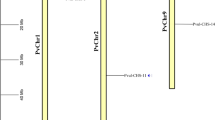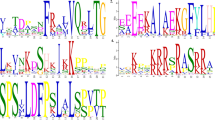Abstract
The extensively cultivated coffee species Coffea arabica is an allotetraploid resulting from a recent hybridization between two wild diploid Coffea species. We describe in this paper the first identification and functional assessment of homoeologous gene copies in C. arabica. When cloning the CaWRKY1 gene encoding a transcription factor of the WRKY superfamily associated with plant defense responses to pathogens (Ganesh et al. in Plant Sci 170:1045–1051, 2006), two distinct gene copies (CaWRKY1a and CaWRKY1b) were obtained from C. arabica. Southern blots experiments and phylogenetic analysis of the WRKY1 gene in related diploid Coffea species showed that CaWRKY1a and CaWRKY1b are homoeologous sequences in the allopolyploid coffee genome and are probably close descents of the extant Coffea canephora and C. eugenioides WRKY1 genes. To verify if CaWRKY1a and CaWRKY1b were both functional, gene expressions were monitored in C. arabica plants challenged by the rust fungus Hemileia vastatrix, the root-knot nematode Meloidogyne exigua, and after several abiotic treatments. Real-time quantitative polymerase chain reaction (PCR) assays showed that CaWRKY1 homoeologs were concomitantly expressed and displayed the same altered patterns of expression in leaves and roots during biotic and abiotic treatments. These results suggest that CaWRKY1a and CaWRKY1b were functionally retained in the coffee genome after allopolyploidization and that no functional divergence occurred between the duplicated genes in the C. arabica genome. This study provides the first molecular data on sub-genome-specific expression in allopolyploid coffee. The origin of the C. arabica sub-genomes is discussed with regards on the probable progenitors of this important crop species.





Similar content being viewed by others
References
AbuQamar S, Chen X, Dhawan R, Bluhm B, Salmeron J, Lam S, Dietrich RA, Mengiste T (2006) Expression profiling and mutant analysis reveals complex regulatory networks involved in Arabidopsis response to Botrytis infection. Plant J 48:28–44
Adams KL, Wendel JF (2005) Polyploidy and genome evolution in plants. Curr Opin Plant Biol 8:135–141
Adams KL, Cronn R, Percifield R, Wendel JF (2003) Genes duplicated by polyploidy show unequal contributions to the transcriptome and organ-specific reciprocal silencing. Proc Natl Acad Sci USA 100:4649–4654
Altschul SF, Madden TL, Schaffer AA, Zhang J, Zhang Z, Miller W, Lipman DJ (1997) Gapped BLAST and PSI-BLAST: a new generation of protein database search programs. Nucleic Acids Res 25:3389–3402
Anthony F, Topart P, Martinez A, Silva M, Nicole M (2005) Hypersensitive-like reaction conferred by the Mex-1 resistance gene against Meloidogyne exigua in coffee. Plant Pathol 54:476–482
Berthaud J, Charrier A (1988) Genetic resources of Coffea. In: Clarke RJ, Macrae R (eds) Coffee, vol. 4: agronomy. Elsevier, London
Bettencourt AJ, Rodrigues CJ (1988) Principles and practice of coffee breeding for resistance to rust and other disease. In: Clarke RJ, Macrae R (eds) Coffee, vol. 4: agronomy. Elsevier, London
Bottley A, Xia GM, Koebner RM (2006) Homoeologous gene silencing in hexaploid wheat. Plant J 47:897–906
Carvalho A (1952) Taxonomia de Coffea arabica L. Caracteres morfológicos dos haploides. Bragantia 12:201–212
Chen C, Chen Z (2002) Potentiation of developmentally regulated plant defense response by AtWRKY18, a pathogen-induced Arabidopsis transcription factor. Plant Physiol 129:706–716
Chen ZJ, Ni Z (2006) Mechanisms of genomic rearrangements and gene expression changes in plant polyploids. Bioessays 28:240–252
Comai L (2005) The advantages and disadvantages of being polyploidy. Nat Rev Genet 6:836–846
Cros J, Combes MC, Trouslot P, Anthony F, Hamon S, Charrier A, Lashermes P (1998) Phylogenetic analysis of chloroplast DNA variation in Coffea L. Mol Phylogenet Evol 9:109–117
Eulgem T (2006) Dissecting the WRKY web of plant defense regulators. PLOS Pathogens 2:1028–1030
Eulgem T, Rushton PJ, Robatzek S, Somssich IE (2000) The WRKY superfamily of plant transcription factors. Trends Plant Sci 5:199–206
Felsenstein J (1981) Evolutionary trees from DNA sequences: a maximum likelihood approach. J Mol Evol 17:368–376
Fernandez D, Santos P, Agostini C, Bon MC, Petitot AS, Silva MC, Guerra-Guimaraes L, Ribeiro A, Argout X, Nicole M (2004) Coffee (Coffea arabica L) genes early expressed during infection by the rust fungus (Hemileia vastatrix). Mol Plant Pathol 5:527–536
Fernandez D, Ramiro D, Petitot AS, Maluf M (2006) Phylogenetic analysis of the WRKY transcription factors gene superfamily in coffee plants.Proceedings of the 21, st International Conference on Coffee Science, Paris, France
Ganesh D, Petitot AS, Silva M, Alary R, Lecouls AC, Fernandez D (2006) Monitoring of the early molecular resistance responses of coffee (Coffea arabica L) to the rust fungus (Hemileia vastatrix) using real-time quantitative RT-PCR. Plant Sci 170:1045–1051
Lashermes P, Combes MC, Trouslot P, Charrier A (1997) Phylogenetic relationships of coffee-tree species (Coffea L.) as inferred from ITS sequences of nuclear ribosomal DNA. Theor Appl Genet 94:947–955
Lashermes P, Combes MC, Robert J, Trouslot P, D’hont A, Anthony F, Charrier A (1999) Molecular characterisation and origin of the Coffea arabica L. genome. Mol Gen Genet 261:259–266
Lecouls AC, Petitot AS, Fernandez D (2006) Early expressed genes in the coffee resistance response to root-knot nematodes (Meloidogyne sp) infection.Proceedings of the 21, st International Conference on Coffee Science, Paris, France
Li J, Brader G, Palva ET (2004) The WRKY70 transcription factor: a node of convergence for jasmonate-mediated and salicylate-mediated signals in plant defense. Plant Cell 16:319–331
Livak KJ, Schmittgen TD (2001) Analysis of relative gene expression data using real-time quantitative PCR and the 2(-ΔΔCT) method. Methods 25:402–408
Liu Y, Schiff M, Dinesh-Kumar SP (2004) Involvement of MEK1 MAPKK, NTF6 MAPK, WRKY/MYB transcription factors, COI1 and CTR1 in N-mediated resistance to tobacco mosaic virus. Plant J 38:800–809
Liu XQ, Bai XQ, Qian Q, Wang XJ, Chen MS, Chu CC (2005) OsWRKY03, a rice transcriptional activator that functions in defense signaling pathway upstream of OsNPR1. Cell Res 15:593–603
Maleck K, Levine A, Eulgem T, Morgan A, Schmid J, Lawton KA, Dangl JL, Dietrich RA (2000) The transcriptome of Arabidopsis thaliana during systemic acquired resistance. Nat Genet 26:403–410
Prentice IC, Jolly D, BIOME 6000 participants (2000) Mid-Holocene and glacial-maximum vegetation geography of the northern continents and Africa. J Biogeogr 27:507–519
Raina SN, Mukai Y, Yamamoto M (1998) In situ hybridisation identifies the diploid progenitor of Coffea arabica (Rubiaceae). Theor Appl Genet 97:1204–1209
Robatzek S, Somssich IE (2001) A new member of the Arabidopsis WRKY transcription factor family, AtWRKY6, is associated with both senescence- and defence-related processes. Plant J 28:123–133
Robatzek S, Somssich IE (2002) Targets of AtWRKY6 regulation during plant senescence and pathogen defense. Genes Dev 16:1139–1149
Rodrigues Jr CJ, Bettencourt AJ, Rijo L (1975) Races of the pathogen and resistance to coffee rust. Annu Rev Phytopathol 13:49–70
Silva MC, Nicole M, Guimaraes L, Rodrigues Jr CJ (2002) Hypersensitive cell death and post-haustorial defense responses arrest the orange rust (Hemileia vastatrix–race II) growth in resistant coffee leaves. Physiol Mol Plant Pathol 60:169–183
Swofford DL (2002) PAUP*: phylogenetic analysis using parsimony (and other methods), 40 Beta. Sinauer, Sunderland, MA, USA
Thomas AS (1944) The wild coffees of Uganda. Emp J ExpAgric 45:1–12
Tao Y, Xie Z, Chen W, Glazebrook J, Chang HS, Han B, Zhu T, Zou G, Katagiri F (2003) Quantitative nature of Arabidopsis responses during compatible and incompatible interactions with the bacterial pathogen Pseudomonas syringae. Plant Cell 15:317–330
Udall JA, Swanson JM, Nettleton D, Percifield RJ, Wendel JF (2006) A novel approach for characterizing expression levels of genes duplicated by polyploidy. Genetics; 173:1823–1827
Ülker B, Somssich IE (2004) WRKY transcription factors: from DNA binding towards biological functions. Curr Opin Plant Biol 7:491–498
Wang D, Amornsiripanitch N, Dong X (2006a) A genomic approach to identify regulatory nodes in the transcriptional network of systemic acquired resistance in plants. PLoS Pathog 2(11):e123
Wang J, Tian L, Lee HS, Wei NE, Jiang H, Watson B, Madlung A, Osborn TC, Doerge RW, Comai L, Chen ZJ (2006b) Genomewide nonadditive gene regulation in Arabidopsis allotetraploids. Genetics 172:507–517
Xie Z, Zhang ZL, Zou X, Huang J, Ruas P, Thompson D, Shen QJ (2005) Annotations and functional analyses of the rice WRKY gene superfamily reveal positive and negative regulators of abscisic acid signaling in aleurone cells. Plant Physiol 137:176–189
Yang SS, Cheung F, Lee JJ, Ha M, Wei NE, Sze SH, Stelly DM, Thaxton P, Triplett B, Town CD, Chen JZ (2006) Accumulation of genome-specific transcripts, transcription factors and phytohormonal regulators during early stages of fiber cell development in allotetraploid cotton. Plant J 47:761–775
Yu D, Chen C, Chen Z (2001) Evidence for an important role of WRKY DNA binding proteins in the regulation of NPR1 gene expression. Plant Cell 13:1527–1540
Zhang Y, Wang L (2005) The WRKY transcription factor superfamily: its origin in eukaryotes and expansion in plants. BMC Evol Bio l5:1
Zheng Z, Qamar SA, Chen Z, Mengiste T (2006) Arabidopsis WRKY33 transcription factor is required for resistance to necrotrophic fungal pathogens. Plant J 48:592–605
Acknowledgements
We would like to thank Dr. F. Anthony (IRD) for helpful discussions on Coffea spp. for phylogenetic analysis. We are greatly indebted to the research center on coffee rusts (CIFC, Oeiras, Portugal) for providing rust isolates. This work was partially supported through a bilateral cooperation between France and Portugal (contract 714 C2, 2003–2004 and Pessoa, 2007–2008) and between France and Brazil (CAPES-COFECUB n° Sv 555/07).
Author information
Authors and Affiliations
Corresponding author
Additional information
Communicated by W. Boerjan
Rights and permissions
About this article
Cite this article
Petitot, AS., Lecouls, AC. & Fernandez, D. Sub-genomic origin and regulation patterns of a duplicated WRKY gene in the allotetraploid species Coffea arabica . Tree Genetics & Genomes 4, 379–390 (2008). https://doi.org/10.1007/s11295-007-0117-x
Received:
Revised:
Accepted:
Published:
Issue Date:
DOI: https://doi.org/10.1007/s11295-007-0117-x




